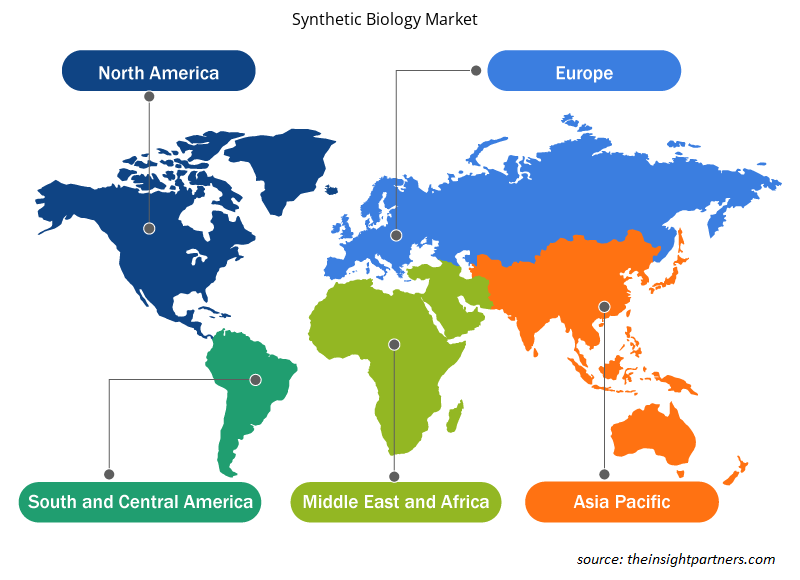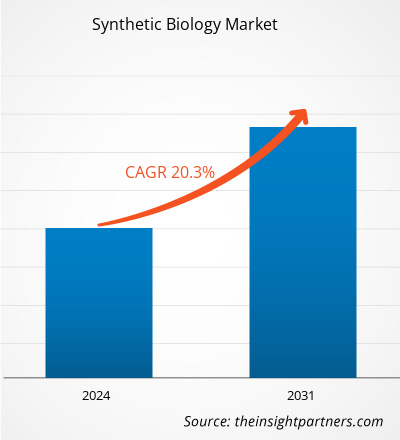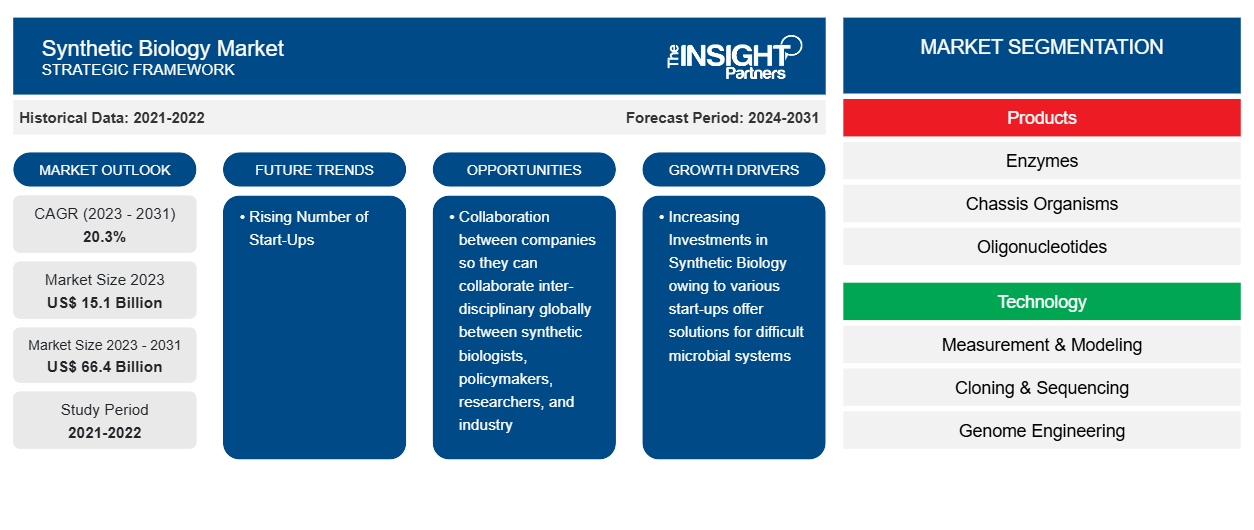合成生物学市场规模预计将从 2023 年的 151 亿美元增至 2031 年的 664 亿美元。预计 2023-2031 年期间该市场的复合年增长率将达到 20.3%。先进的合成生物学很可能仍是市场的主要趋势。
合成生物学市场分析
推动市场增长的关键因素是对合成生物学的投资增加以及初创企业数量的增加。合成生物学为公司提供了广泛的机会,使合成生物学家、政策制定者、研究人员和行业能够在全球范围内进行跨学科合作。例如,2021 年 8 月,Codex DNA 宣布与美国农业部开展合成生物学合作,以确定可扩展的柑橘黄龙病治疗方法。
合成生物学市场概况
合成生物学是一个新兴概念,在化学、农业、制药和能源行业有着广泛的应用。各种初创公司都为复杂的微生物系统提供解决方案。例如,美国初创公司 Asimov 为哺乳动物合成生物学提供了基因设计平台。他们将合成生物学、多组学测量、计算建模和机器学习整合到一个平台中,以推进治疗应用。此外,Benchling 提供 CAD 工具,GenScript 提供基因合成,Ginkgo Bioworks 协助生物工程,Transcriptis(一家生物信息学公司)提供促进云实验室/自动化的解决方案,Glowee 提供消费产品。
定制此报告以满足您的需求
您可以免费定制任何报告,包括本报告的部分内容、国家级分析、Excel 数据包,以及为初创企业和大学提供优惠和折扣
- 获取此报告的关键市场趋势。这个免费样品将包括数据分析,从市场趋势到估计和预测。
合成生物学市场驱动因素和机遇
初创企业数量不断增加
生物技术企业家可以从其所在国政府快速筹集资金并采购设备和空间。例如,印度政府资助印度理工学院马德拉斯分校的 IITM Bioincubator 建立了一个生物信息学基础设施和一个尖端癌症生物学研究中心。包括科学技术部 (DST)、生物技术部 (DBT) 和科学与工业研究理事会 (CSIR) 在内的组织提供了资金。在中国,Chinaccelerator 是一家提供辅导计划来帮助初创企业的融资机构。它还与 SOSV Investments LLC 有合作关系,后者通过 RebelBio 和 Indie Bio 等计划提供资金来帮助初创企业的建立。创意资金的易得性激励着世界各地的企业家建立合成生物学企业。
公司间合作
合成生物学是生物技术的一个分支,它将为医疗保健领域的几乎每个方面提供机会,包括药物输送、蛋白质疗法、生物燃料以及食品和农产品开发。它为生物技术企业家提供了加速发现、减少临床失败和提高成本效益的机会。合成生物学为公司提供了广泛的机会,使合成生物学家、政策制定者、研究人员和行业能够在全球范围内进行跨学科合作。例如,2021 年 8 月,Riffyn Inc. 和帝国理工学院中心合作开展合成生物学 (IC-CSynB),SynbiCITE 的伦敦生物研究中心为合成生物学研究和科学可重复性教育而设立。这些是促使公司在合成生物学市场中成长的主要因素,并可能在预测期内影响市场增长。
合成生物学市场报告细分分析
有助于得出合成生物学市场分析的关键部分是产品、技术和应用。
- 根据产品,合成生物学市场细分为酶、底盘生物、寡核苷酸和异种核酸。寡核苷酸部分在 2023 年占据了更大的市场份额。
- 根据技术,市场细分为测量和建模、克隆和测序、基因组工程、基因合成、纳米技术等。基因合成领域在 2023 年占据了最大的市场份额。
- 根据应用,市场分为医疗应用、工业应用、食品和农业、环境应用等。医疗应用领域在 2023 年占据了最大的市场份额。
合成生物学市场份额按地区分析
合成生物学市场报告的地理范围主要分为五个区域:北美、亚太、欧洲、中东和非洲、南美和中美。
合成生物学是生物技术进步的重要工具,不仅可能用于生物武器的开发,还可能对人类健康产生不可预见的负面影响,以及对环境造成潜在的影响,可通过政策立法规范行业生物技术的使用,避免安全问题。
政府提供的各种举措和资金为美国合成生物学市场的发展提供了极好的支持。例如,根据美国国家生物技术信息中心 (NCBI) 的报告,美国政府每年为合成生物学研发提供约 2.2 亿美元的资金。该基金的投资来自能源部、国家科学基金会 (NSF)、国防部 (DoD)(包括 DARPA)、国立卫生研究院 (NIH) 和美国农业部 (USDA)。
合成生物学市场区域洞察
Insight Partners 的分析师已详细解释了预测期内影响合成生物学市场的区域趋势和因素。本节还讨论了北美、欧洲、亚太地区、中东和非洲以及南美和中美洲的合成生物学市场细分和地理位置。

- 获取合成生物学市场的区域特定数据
合成生物学市场报告范围
| 报告属性 | 细节 |
|---|---|
| 2023 年的市场规模 | 151亿美元 |
| 2031 年市场规模 | 664亿美元 |
| 全球复合年增长率(2023 - 2031) | 20.3% |
| 史料 | 2021-2022 |
| 预测期 | 2024-2031 |
| 涵盖的领域 | 按产品分类
|
| 覆盖地区和国家 | 北美
|
| 市场领导者和主要公司简介 |
|
市场参与者密度:了解其对商业动态的影响
合成生物学市场正在快速增长,这得益于终端用户需求的不断增长,而这些需求又源于消费者偏好的不断变化、技术进步以及对产品优势的认识不断提高等因素。随着需求的增加,企业正在扩大其产品范围,进行创新以满足消费者的需求,并利用新兴趋势,从而进一步推动市场增长。
市场参与者密度是指在特定市场或行业内运营的企业或公司的分布情况。它表明在给定市场空间中,相对于其规模或总市场价值,有多少竞争对手(市场参与者)存在。
在合成生物学市场运营的主要公司有:
- 赛默飞世尔科技公司
- 安捷伦科技公司
- 默克集团
- 新英格兰生物实验室
- 集成 DNA 技术
- Twist 生物科学
免责声明:上面列出的公司没有按照任何特定顺序排列。

- 了解合成生物学市场顶级关键参与者概况
合成生物学市场新闻和最新发展
合成生物学市场通过收集一级和二级研究后的定性和定量数据进行评估,其中包括重要的公司出版物、协会数据和数据库。合成生物学市场的一些发展如下:
- bit.bio 和 Ginkgo Bioworks 宣布 bit.bio 成为 Ginkgo 技术网络的首批合作伙伴。该网络是一个开创性的尖端技术合作伙伴生态系统,致力于与 Ginkgo 合作提供新的集成功能,以推动客户研发项目的成功。(来源:bit.bio,公司网站,2024 年 2 月)
- 住友化学株式会社和 Ginkgo Bioworks 宣布了一项新计划,旨在利用合成生物学开发功能性化学品,并扩大两家公司现有的生物制造合作伙伴关系。(来源:住友化学株式会社,公司网站,2023 年 7 月)
合成生物学市场报告范围和交付成果
“合成生物学市场规模和预测(2021-2031)”报告对以下领域进行了详细的市场分析:
- 合成生物学市场规模及全球、区域和国家层面所有主要细分市场的预测
- 合成生物学市场趋势以及市场动态,如驱动因素、限制因素和关键机遇
- 详细的 PEST/波特五力分析和 SWOT 分析
- 合成生物学市场分析涵盖主要市场趋势、全球和区域框架、主要参与者、法规和最新的市场发展。
- 行业格局和竞争分析,涵盖市场集中度、热图分析、知名参与者以及合成生物市场的最新发展
- 详细的公司简介
- 历史分析(2 年)、基准年、预测(7 年)及复合年增长率
- PEST和SWOT分析
- 市场规模、价值/数量 - 全球、区域、国家
- 行业和竞争格局
- Excel 数据集
近期报告
相关报告
客户评价
购买理由
- 明智的决策
- 了解市场动态
- 竞争分析
- 客户洞察
- 市场预测
- 风险规避
- 战略规划
- 投资论证
- 识别新兴市场
- 优化营销策略
- 提升运营效率
- 顺应监管趋势





















 获取免费样品 - 合成生物学市场
获取免费样品 - 合成生物学市场